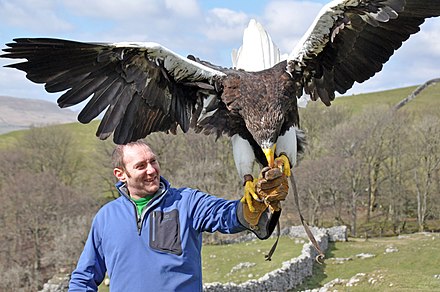Steller’s sea eagles (Haliaeetus pelagicus) are not cold-blooded, but rather warm-blooded birds, a characteristic of the class Aves. These magnificent eagles are known for their striking appearance, with a dark body and white tail, shoulders, rump, thighs, and forehead. As the largest eagle species in the world, they have a wingspan reaching up to 8 feet (2.5 m) and weigh between 13 to 20 lbs (6 to 9 kg).
Habitat and Distribution of Steller’s Sea Eagles
Steller’s sea eagles are native to the Russian Far East and coastal Japan, primarily breeding in the Sea of Okhotsk and Bering Sea regions, particularly on the Kamchatka Peninsula. During the winter months, many of these eagles migrate to Japan, while others move to open water as the temperature drops.
Feeding Habits of Steller’s Sea Eagles
 Image source: stellers sea eagle
Image source: stellers sea eagle
The diet of Steller’s sea eagles mainly consists of fish, with salmon being their primary food source in their breeding grounds. They hunt and scavenge for fish, often taking advantage of annual salmon runs. In Japan, their diet expands to include cod, crabs, shellfish, squid, small animals, ducks, gulls, and carrion.
These eagles have a unique hunting style, often hunting from a perch or in flight by diving and clutching prey in their powerful talons. They also stand in shallow water or on the ice and grab passing fish when the opportunity arises. Steller’s sea eagles are known for their power and aggression, considered the most powerful and aggressive of their cousins, the bald eagle and the white-tailed sea eagle.
Conservation Status of Steller’s Sea Eagles
Although Steller’s sea eagles do not occur in large numbers, their populations appear to be stable. Their feathers were once highly prized, but today, these magnificent birds are protected throughout their range, especially in Japan, where they are known as O-washi and revered.
Sightings of Steller’s Sea Eagles in North America
In recent years, there have been sightings of Steller’s sea eagles in North America, with one individual traveling from Alaska to Texas, then to various locations in Canada and the eastern United States, before being spotted in Newfoundland and Maine. These sightings have generated interest and excitement among birdwatchers and the general public, highlighting the eagle’s remarkable adaptability and resilience.
Unique Characteristics of Steller’s Sea Eagles
Steller’s sea eagles are known for their impressive size, with a wingspan that can reach up to 8 feet (2.5 m) and a weight range of 13 to 20 lbs (6 to 9 kg). They have a distinctive dark body and white tail, shoulders, rump, thighs, and forehead, making them easily recognizable.
These eagles are also known for their powerful hunting abilities, often diving from a perch or in flight to capture their prey. They are considered the most powerful and aggressive of their cousins, the bald eagle and the white-tailed sea eagle.
Conclusion
In conclusion, Steller’s sea eagles are not cold-blooded, but rather warm-blooded birds, a characteristic of the class Aves. These magnificent eagles are native to the Russian Far East and coastal Japan, and their populations appear to be stable despite their relatively low numbers. The recent sightings of Steller’s sea eagles in North America have generated excitement and interest among birdwatchers and the general public, highlighting the eagle’s remarkable adaptability and resilience.
References:
– Animals – Steller’s Sea-eagle | San Diego Zoo Animals & Plants. (n.d.). Retrieved from https://animals.sandiegozoo.org/animals/stellers-sea-eagle
– Steller’s sea eagle – Wikipedia. (n.d.). Retrieved from https://en.wikipedia.org/wiki/Steller%27s_sea_eagle
– Stellers Sea Eagle – Haliaeetus pelagicus – Carnivora. (n.d.). Retrieved from https://carnivora.net/stellers-sea-eagle-haliaeetus-pelagicus-t2363.html

